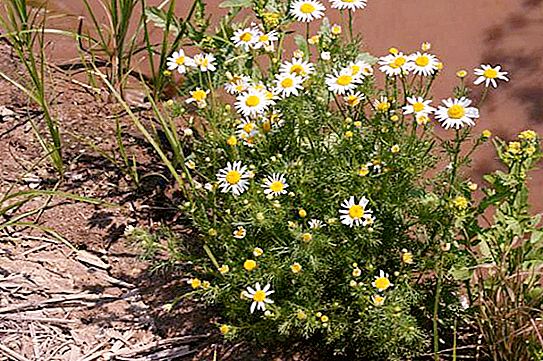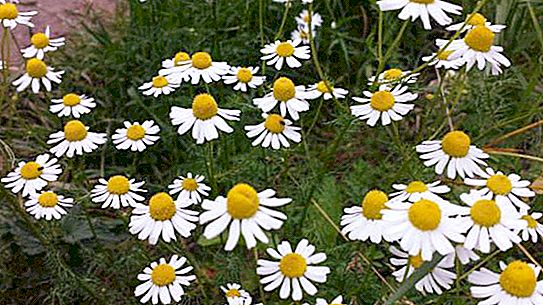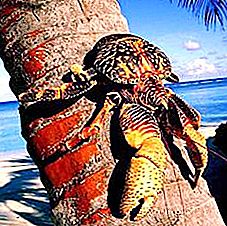A small white flower on a straight branchy stem attracts the attention of many, as passers-by confuse it with a medicinal plant called a chamomile. But it is worth leaning lower, as the obvious difference becomes noticeable - the flower has no smell at all. The thing is that this is odorless chamomile, that is, a weed spread in the fields and gardens.

View description
The Latin name of this representative of the plant kingdom is Matricaria inodora L. The people call a white flower a dog chamomile, wild chamomile or matronka. The class to which the plant belongs is dicotyledonous. The flower belongs to the aster family. The genus of the plant is the trihedral.
It is visually difficult to imagine how odorless chamomile may be related to asters. The family unites a large group of herbaceous plants with a complex flower representing a basket of small flowers. They can be tubular or reed, and some representatives have a mixed basket. The odorless chamomile in a basket combines both tubular and reed flowers, which fully corresponds to the declared family.
The odorless chamomile stem is quite high; it can rise up to 70 cm above the ground. Inside, the stem is hollow, and on the outside it is furrowed. Its leaves are cirrus-dissected, consisting of filamentous lobes. Type of inflorescence is a round-shaped basket. It is located at the ends of stems or branches. The leaves covering the basket have a blunt, elongated shape, the receptacle is slightly conical. Marginal flowers of a basket of reed form of white color. They are longer than the covering petals. The middle part of the inflorescence consists of yellow tubular flowers.
What does the plant look like?
The odorless chamomile has a few flattened achenes of a dark brown color. A distinctive feature of the fetus is a short leathery crest. The length of each achene is not more than 2 mm, the width is 1 mm. The weight is also quite small, it can range from 0.2 to 0.5 mg.
The shape of the fruit is reflected in the name of the genus of the plant. It is precisely because the achene has three distinct faces that the odorless chamomile was attributed to the genus of trihedrals.
Where is the plant found?
Odorless chamomile is a weed that clogs grain fields and fodder meadows. It is found in cottages and gardens, on roadsides and around landfills. Often weeds are found along the shores of water bodies. The plant is especially dangerous for winter rye crops near forest plantations.
Odorless chamomile requires a certain level of humidity, so in drier places it gradually moves to beams, ravines and lowlands. The plant spread widely throughout Europe, captured Russia, Belarus, Ukraine, the countries of the Lesser Caucasus and partially China.
Not very abundant dog chamomile thickets are found in North Asia and America.
Some odorless chamomile features
Matronka blooms from mid-May to late autumn. The flower propagates with the help of seeds, which in large quantities ripen in each plant. One odorless chamomile produces up to 30 thousand seeds per season. If the plant is bushy, then this figure is much higher. Seeds clog the soil and spread with the feet of people and animals, as well as with the wind. Seed germination persists for a long time (up to 6 years).
Economic value of the plant
By the content of essential oils, odorless chamomile, the photo of which is found in textbooks and reference books, is significantly inferior to the chamomile. Therefore, this species is not considered as a medicinal plant. Although at home it is sometimes dried and used for treatment.
Dog chamomile is also not used as a fodder crop, as animals bypass it on pastures. From this the conclusion suggests itself that odorless chamomile has no economic value and can only be considered as a weed.







